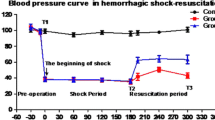Abstract
Objective: To observe the effects of three fluid resuscitation methods on apoptosis of visceral organs in rats with hemorrhagic shock. Methods: A model of rat with severe hemorrhagic shock and active bleeding was established in 32 SD (Sprague-Dawley) rats. The rats were randomly divided into control group, no fluid resuscitation group (NF group), controlled fluid resuscitation group (NS40 group) and rapid large scale fluid resuscitation group (NS80 group). Each group contained 8 rats. The curative effects were compared. At the same time, the apoptosis in liver, kidney, lung and small intestinal mucosa of survivors after hemorrhage and resuscitation was detected by light microscopy in HE (hematoxylin and eosin) stained tissue sections, flow cytometry and terminal deoxynucleotidyl transferase dUTP nick end labelling (TUNEL). Results: The survival rate of early fluid resuscitation (14/16) was markedly higher than that of NF group (3/8). There was some apoptosis in liver, kidney, lung and small intestinal mucosa of all survivors. Compared with NF and NS40 groups, the apoptosis of liver, kidney and small intestinal mucosa of NS80 group was obviously increased. Conclusions: Among three fluid resuscitation methods, controlled fluid resuscitation can obviously improve the early survival rate and the apoptosis of liver, kidney and small intestinal mucosa in rats with severe and uncontrolled hemorrhagic shock, and may benefit improvement of prognosis.
Similar content being viewed by others
References
Angele, M.K., Xu, Y.X., Ayala, A., Schwacha, M.G., Catania, R.K., Cioffi, W.G., Bland, K.I., Chaudry, I.H., 1999. Gender dimorphism in trauma-hemorrhage-induced thymocyte apoptosis.Shock,12: 316–322.
Bickell, W.H., Wall, M.J., Jr, Pepe, P.E., Martin, R.R., Ginger, V.F., Allen, M.K., Mattox, K.L., 1994. Immediate versus delayed fluid resuscitation for hypotensive patients with penetrating torso injuries.N. Engl. J. Med.,331: 1105–1109.
Burris, D., Rhee, P., Kaufmann, C., Pikoulis, E., Austin, B., Eror, A., DeBraux, S., Guzzi, L., Leppaniemi, A., 1999. Controlled resuscitation for uncontrolled hemorrhagic shock.J. Trauma,46: 216–223.
Capone, A.C., Safar, P., Stezoski, W., Tisherman, S., Peitzman, A.B., 1995. Improved outcome with fluid restriction in treatment of uncontrolled hemorrhagic shock.J. Am. Coll. Surg.,180: 49–56.
Chen, X.X., Ye, G.S., Shuai, X.J., Zhu, J., Li, D.P., Yue, C.H., 2004. Healing effect of limited fluid resuscitation treatments on severe thoracic trauma accompanied with hemorrhagic traumatic shock.Chin. J. Crit. Care. Med.,24: 178–180.
Guan, J., Jin, D.D., Jin, L.J., 1998. Apoptosis in multiple organs of rats in early stage of polytrauma combined with shock.Natl. Med. J. China,78: 741–745 (in Chinese).
Kim, S.H., Stezoski, S.W., Safar, P., Capone, A., Tisherman, S., 1997. Hypothermia and minimal fluid resuscitation increase survival after uncontrolled hemorrhagic shock in rats.J. Trauma.,42: 213–222.
Meldrum, D.R., Shenkar, R., Sheridan, B.C., Cain, B.S., Abraham, E., Harken, A.H., 1997. Hemorrhage activates myocardial NF-kappaB and increases TNF-alpha in the heart.J. Mol. Cell Cardiol.,29: 2849–2854.
Revell, M., Greaves, I., Porter, K., 2003. Endpoints for fluid resuscitation in hemorrhagic shock.J. Trauma.,54: 63–67.
Xu, Y.X., Ayala, A., Monfils, B., Cioffi, W.G., Chaudry, I.H., 1997. Mechanism of intestinal mucosal immune dysfunction following trauma-hemorrhage: Increased apoptosis associated with elevated Fas expression in Peyer's patches.J. Surg. Res.,70: 55–60.
Yu, Z.Y., Ono, S., Spatz, M., McCarron, R.M., 2002. Effect of hemorrhagic shock on apoptosis and energy-dependent efflux system in the brain.Neurochem. Res.,27: 1625–1632.
Zhang, S., Chen, R.K., Lin, M., He, X.M., 2004. Dynamic change of apoptosis of alveolar cells in ischemia-reperfusion induced pulmonary: An experimental study with rats.Natl. Med. J. China,84: 1597–1600 (in Chinese).
Author information
Authors and Affiliations
Corresponding author
Rights and permissions
About this article
Cite this article
Yuan-qiang, L., Xiu-jun, C., Lin-hui, G. et al. Effects of three fluid resuscitation methods on apoptosis of visceral organs in rats with hemorrhagic shock. J. Zheijang Univ.-Sci. B 6, 907–912 (2005). https://doi.org/10.1007/BF02841002
Received:
Accepted:
Issue Date:
DOI: https://doi.org/10.1007/BF02841002




